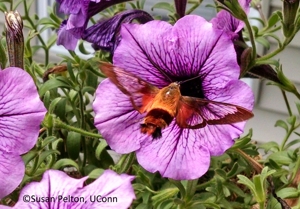Annuals have so much to offer with their continuous bloom and wide assortment of colors, flower shapes and sizes. There are plenty of choices for both the sun and the shade and even a fair number that can tolerate droughty conditions. Some are perfect for bedding while others perform superbly in containers and hanging baskets.
Keep in mind that annuals are fast-growing, short-lived plants. They germinate from seed, grow, bloom, set seed and die all within a single growing season. As such, they need care consistent with their cultural requirements for optimal display.
 Water Requirements
Water Requirements
This means supplying them with enough water and nutrients to keep pace with their rapid growth. Regular watering is essential. As with most plants, annuals require about an inch of water at least once a week to keep plants looking good and to producing more blossoms. Even drought tolerant species need water to get established and also during long dry spells. Check to see that plants are getting adequate water by either digging down after watering to see how deep the water has penetrated or set out a container and water until the one inch of water is collected.
Mulching your annual plantings will keep weeds down and also decrease evaporation. This means that the soil under mulched plants will stay moist longer. Any organic material can serve as a mulch but fine-textured shredded bark, cocoa bean hulls or buckwheat hulls may be more in keeping with the scale of smaller annuals. Usually only an inch or so of mulch is necessary around annuals. See Mulch Basics for additional information.
Fertilizer Requirements
Annuals perform best when given adequate amounts of nutrients. Either a natural organic or synthetic fertilizer can be used depending on your preference. Generally about 2 cups of a 5-10-10 fertilizer is mixed into every 100 square feet of soil before planting. For annuals that bloom all summer like marigolds, zinnias and petunias, sidedress with about the same amount of fertilizer mid-summer or use a liquid fertilizer and fertilizer as you water. Suggested Fertilizer Practices for Flowering Plants for additional information.
Cool Season Annuals
The two main groups of annuals are divided by temperature preferences. Cool season annuals like pansies, larkspur and calendulas will look a little ragged in the heat of summer. Pansies and calendulas can be cut back and will regrow and bloom vigorously again as the temperatures get a little cooler. Larkspurs and annual phlox have a tendency to peter out.
Warm Season Annuals
Warm season annuals such as zinnias, tithonias, portulacas, and morning glories, among others, like the summer heat as long as they have adequate water. They will continue to bloom until a frost hits.
Deadheading/Pinching
An annual’s main purpose is life is to set seed. Removing spent flowers, aptly termed dead-heading, will prolong the blooming period. Use gardening shears or pruners and remove blossoms as they fade. Plan on dead-heading on a weekly basis.
Some annual species like impatiens, begonias, portulacas and annual vinca are relatively self-cleaning so no dead-heading is necessary. Lightly shear sweet alyssum and dwarf bachelor buttons when flowers look spent for a second flush of bloom.
Leggy petunias, verbena and coleus can be pinched or cut back to promote bushier plants. The tips of the coleus plants can be rooted in water for colorful winter houseplants. Often it is recommended that the purple coleus flowers be removed but the hummingbirds will enjoy them. Even the Wave petunias get leggy and it is often advisable to not only remove spent flowers but cut back long stems to make for a fuller, neater plant especially when used in containers.
In the case of self-seeding annuals like calendula, balsam, bachelor buttons, alyssum, celosia and nicotiana, allow some seeds to form towards the end of the growing season so that you will have new seedlings next spring.
A little care, in the case of annuals, can go a long way. Keep plants watered, fed and dead-headed and they will reward you with a bounty of blossoms until their lives are ended with fall frosts.
Despite good cultural practices, pests and diseases at times may appear. Chemical control should be used only after all other methods have failed. For pesticide information please call UConn Home and Garden Education Center or your local cooperative extension office.
The UConn Home & Garden Education Center supports UConn Extension’s mission by providing answers you can trust with research-based information and resources. For gardening questions, contact us toll-free at (877) 486-6271, visit our website at homegarden.cahnr.uconn.edu, or reach out to your local UConn Extension center at cahnr.uconn.edu/extension/locations.
UConn Home and Garden Education Center, 2019.